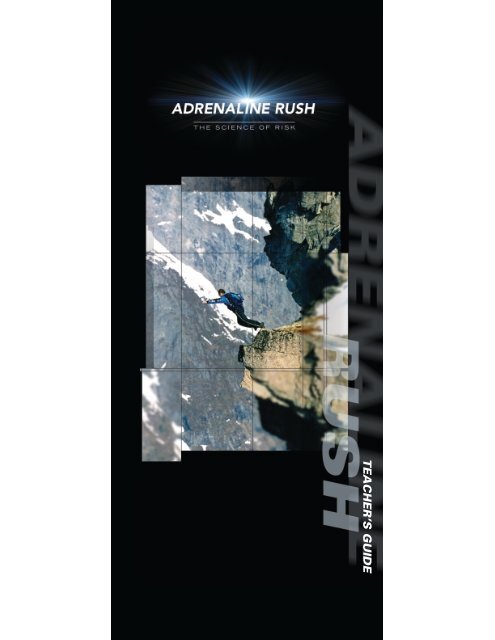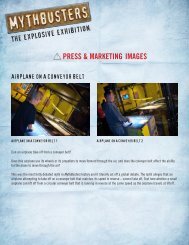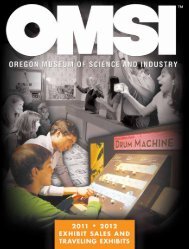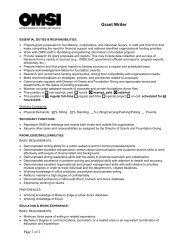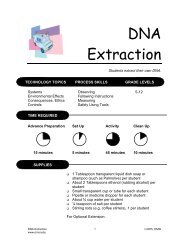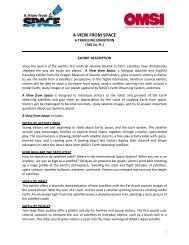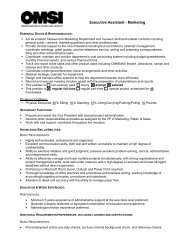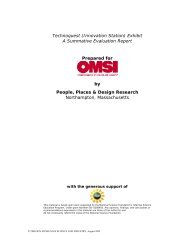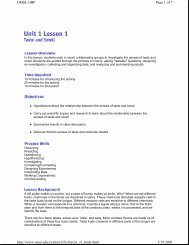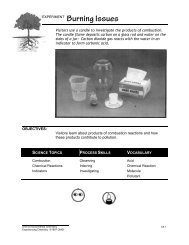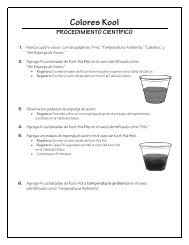ADRENALINE RUSH: THE SCIENCE OF RISK - Big Movie Zone
ADRENALINE RUSH: THE SCIENCE OF RISK - Big Movie Zone
ADRENALINE RUSH: THE SCIENCE OF RISK - Big Movie Zone
You also want an ePaper? Increase the reach of your titles
YUMPU automatically turns print PDFs into web optimized ePapers that Google loves.
TEACHER’S GUIDE
<strong>ADRENALINE</strong> <strong>RUSH</strong>: <strong>THE</strong> <strong>SCIENCE</strong> <strong>OF</strong> <strong>RISK</strong><br />
guide<br />
ABOUT THIS GUIDE<br />
This teacher’s guide to Adrenaline Rush provides a series of<br />
modules and information sheets that allow students to further<br />
explore the world of risk through the world of skydiving and<br />
base jumping. It addresses issues like:<br />
> how risk is part of our daily lives;<br />
> why certain people take more risks than others;<br />
> how people seek to manage and minimize risks,<br />
even in extreme activities<br />
> how science, innovation and risk are linked<br />
> the history of parachuting, from Leonardo da Vinci<br />
to today<br />
The first part of the guide, entitled Quick Jumps, provides seven<br />
two-page modules: the first page provides a short overview of<br />
the proposed theme and the second page provides suggested<br />
activities and questions.<br />
movie<br />
ABOUT <strong>THE</strong> MOVIE<br />
Adrenaline Rush takes a look at the world of skydiving and<br />
base jumping. It explores how the risk-taking involved in such<br />
extreme activities can tell us about the world of science and<br />
innovation, and about the way we deal with risk in our daily<br />
lives. It focuses on two risk-takers, Adrian Nicholas and<br />
Katarina Ollikainen, as they prepare to undertake a unique scientific<br />
experiment: trying to fly the parachute imagined in 1485<br />
by Leonardo da Vinci, the very first parachute design ever<br />
recorded in the world.<br />
While providing breathtaking views of skydiving over the<br />
Florida Keys, the Mojave desert and in the magnificent Fjords<br />
of Norway, Adrenaline Rush explores the psychological and<br />
physiological forces behind risk-taking, and the physics<br />
involved in these activities. The movie shows us that while<br />
most of us will never go to such extremes, risk can lead to<br />
unexpected discoveries and help mankind fulfill its dreams.<br />
The second part, entitled For a <strong>Big</strong>ger Rush, provides more indepth<br />
explorations of some of the movie’s themes with proposals<br />
for further reading.<br />
1
<strong>ADRENALINE</strong> <strong>RUSH</strong>: <strong>THE</strong> <strong>SCIENCE</strong> <strong>OF</strong> <strong>RISK</strong><br />
Table of Contents<br />
2 Introduction<br />
Part 1:<br />
QUICK JUMPS<br />
4 Safety and Risk: Managing our Daily Lives<br />
6 MAO and Me: Why Some People Take the Plunge<br />
8 Before the Rush: Experience and Training<br />
10 Leonardo da Vinci: Imagining Flight<br />
12 Past and Present: The 15th Century Meets the 21st<br />
14 The Science of Flight: A Quick Look at Aerodynamics<br />
16 Opening New Possibilities: Science and Risk<br />
Part 2:<br />
FOR A BIGGER <strong>RUSH</strong><br />
17 Different Types of Risk<br />
18 Leonardo da Vinci: A True Renaissance Man<br />
19 From Imagination to Science: The History of Parachuting<br />
20 Deformable Structures and Fluid Flows: What’s That?<br />
21 Capturing Risk: The Making of Adrenaline Rush<br />
3
PART 1 / QUICK JUMPS / SAFETY AND <strong>RISK</strong>: MANAGING OUR DAILY LIVES<br />
Part 1:<br />
QUICK JUMPS<br />
SAFETY<br />
AND <strong>RISK</strong>:<br />
Managing our Daily Lives<br />
Risk is an unavoidable part of life. We work very<br />
hard to make our lives as safe as possible. Locks,<br />
safety belts, passwords, helmets, smoke detectors,<br />
fire alarms, traffic signals, lifejackets and security<br />
guards are part of our daily lives.<br />
Still, accidents can happen, and ill-intentioned people<br />
can put us at risk. We can become sick or be a victim<br />
of circumstances beyond our control. What<br />
makes us go on with our daily lives is our confidence<br />
that everything will go right and that we can manage<br />
the risks we take.<br />
When we ride a car, we trust that it is safe and that<br />
the driver knows all the rules and the necessary precautions.<br />
When we jump in a pool, we rely on the<br />
skills we learned through swimming lessons. If we<br />
walk across a street, we wait for a green light and<br />
we trust that cars will stop at the red light.<br />
Extreme thrill seekers may take risks that most of us<br />
wouldn’t. But even they do everything to make<br />
things safe, and they trust their experience and skills<br />
to avoid harm.<br />
4
<strong>ADRENALINE</strong> <strong>RUSH</strong>: <strong>THE</strong> <strong>SCIENCE</strong> <strong>OF</strong> <strong>RISK</strong><br />
As they take chances that<br />
may endanger their lives,<br />
risk-takers and thrill-seekers<br />
rely on one basic thing: trust.<br />
They have to trust their<br />
equipment and their skills.<br />
They must be confident that<br />
every factor is taken into<br />
account before they go<br />
ahead and face danger. Very<br />
often, they need to trust<br />
other people – the partners<br />
who make their experiences<br />
possible.<br />
To Do:<br />
Here’s an exercise in trust that you can do with a partner:<br />
Stand in front of your partner, with both of you facing the same direction.<br />
You should be at arm’s length from your partner: when your partner<br />
holds his or her arms straight out, he or she should touch the back<br />
of your shoulders with his or her fingers.<br />
Cross your arms and close your eyes. When your partner gives you a<br />
clear signal, let yourself fall backwards, resisting the urge to bend your<br />
legs or pull your arms back. It is your partner’s job to catch you with<br />
both hands.<br />
After you have done this, change places with your partner and repeat<br />
the experiment.<br />
Here’s a few questions to ask yourself<br />
after you’ve tried your trust:<br />
Did you manage to take that risk? Why? Why not?<br />
Did you feel afraid? Why? Why not?<br />
Did you feel a “rush” before your partner caught you?<br />
Did you feel good or bad after taking this risk? Why?<br />
WARNING: PICK A PARTNER THAT IS ABOUT <strong>THE</strong> SAME SIZE AS<br />
YOU ARE, AND DO THIS EXPERIMENT IN AN OPEN SPACE, AWAY<br />
FROM TABLES, CHAIRS OR O<strong>THE</strong>R HARD OBJECTS.<br />
5
PART 1 / QUICK JUMPS / MAO AND ME: WHY SOME PEOPLE TAKE <strong>THE</strong> PLUNGE<br />
MAO<br />
AND ME:<br />
WHY SOME PEOPLE TAKE<br />
<strong>THE</strong> PLUNGE<br />
Why do most people run from danger, while some run to it?<br />
Some scientists now believe they may have found the answer<br />
to that question – an answer located in the complex chemistry<br />
of the human brain.<br />
Inside the brain are billions of special molecules called neurotransmitters.<br />
It is by controlling the flow of these molecules<br />
that we formulate thoughts, make decisions and experience<br />
various sensations and feelings. One particular neurotransmitter<br />
called “serotonin” is linked with feelings of well-being and<br />
anxiety.<br />
Serotonin levels are regulated by another molecule called<br />
Monoamine Oxidase (MAO) and extreme risk takers tend to<br />
have about a third less MAO than the average person. It is<br />
interesting to note that while low MAO levels are found in athletes,<br />
performers, entrepreneurs and artists, they are also common<br />
among those prone to anti-social behavior like crime and<br />
drug or alcohol addiction – less recommendable kinds of risktaking.<br />
Still, MAO is just one of many factors that shape a human<br />
being. Personality, family and social context can also intervene,<br />
as well as other factors like the male hormone testosterone or<br />
a gene called D4DR which can cause variations in the levels of<br />
another neurotransmitter called dopamine.<br />
Serotonin<br />
In other words, brain chemicals alone cannot explain why most<br />
people choose the safe route and why some will prefer taking<br />
chances and risks. Personality, upbringing and education, or<br />
even the encouragement of peers can lead us either way.<br />
MAO<br />
6
<strong>ADRENALINE</strong> <strong>RUSH</strong>: <strong>THE</strong> <strong>SCIENCE</strong> <strong>OF</strong> <strong>RISK</strong><br />
To Do:<br />
Are you a risk-taker? Do<br />
you like to step off the<br />
beaten track? How much<br />
do you value personal<br />
safety? Here are a few<br />
questions to help you<br />
define your attitude<br />
towards risk. After you<br />
have answered the questions,<br />
you can discuss<br />
them with the rest of the<br />
class.<br />
You can also use this<br />
questionnaire as an informal<br />
poll of the class, compiling<br />
all the answers to<br />
get a group portrait.<br />
1, Do you participate in competitive sports?<br />
What is your favorite sport?<br />
Why?<br />
2. Are you afraid of heights?<br />
a) Yes<br />
b) No<br />
3. When you get a new device (computer, game, tool, etc.), do<br />
you read the instruction manual?<br />
a) Always, before I start using it<br />
b) Most of the time, as I try new features<br />
c) Only for troubleshooting<br />
d) Never, I rely on instinct and skill<br />
4. Rate the following activities from 0 to 5,<br />
with 0 meaning you try to avoid it and<br />
5 meaning you love to do it.<br />
How much do you like to:<br />
1) try new foods?<br />
2) travel to new places?<br />
3) meet new people?<br />
4) try new sports or hobbies?<br />
5) set new goals or challenges for yourself?<br />
6) engage in strenuous physical activities?<br />
7) ride roller coasters?<br />
1 2 3 4 5<br />
1 2 3 4 5<br />
1 2 3 4 5<br />
1 2 3 4 5<br />
1 2 3 4 5<br />
1 2 3 4 5<br />
1 2 3 4 5<br />
7
PART 1 / QUICK JUMPS / BEFORE <strong>THE</strong> <strong>RUSH</strong> : EXPERIENCE AND TRAINING<br />
Before<br />
the Rush:<br />
Experience and Training<br />
Very few people will ever go skydiving. Even fewer will<br />
ever try base jumping.<br />
Before they decide to jump off a 4,100-feet cliff (1,300<br />
meters), like those seen in the movie, these thrill seekers<br />
spend a long time building up the knowledge that<br />
can make the experience as safe as possible. They<br />
learn a number of safety measures, technical skills and<br />
procedures, until every move becomes second nature.<br />
Before establishing the world record for the longest sky<br />
dive or trying out Leonardo’s parachute, Adrian Nicholas<br />
had done approximately 6,500 previous dives. His wingsuit<br />
was tested in the safety of a wind tunnel, before<br />
actual jumps were taken. An experienced engineer<br />
helped evaluate the potential of Leonardo’s parachute<br />
before it was built.<br />
A lot of practice and a lot of tests, to minimize risk and<br />
make things as safe as possible.<br />
8
<strong>ADRENALINE</strong> <strong>RUSH</strong>: <strong>THE</strong> <strong>SCIENCE</strong> <strong>OF</strong> <strong>RISK</strong><br />
To Do:<br />
Adrian Nicholas, the world<br />
record-holder for the<br />
longest unassisted human<br />
flight has jumped up to<br />
2,500 times in one year.<br />
How many jumps a day does<br />
Adrian make?<br />
Before trying out for his<br />
world record, Adrian had<br />
done around 6,500 jumps.<br />
If you jumped only once a day,<br />
how many years would it take<br />
you to be ready for the world<br />
record?<br />
When he established his world record,<br />
Adrian’s unassisted flight lasted 4 minutes<br />
and 55 seconds, thanks to a revolutionary<br />
wing-suit. His speed during that record flight<br />
reached 120 miles per hour (200 kilometers<br />
per hour).<br />
How far did he travel? (round the time to five minutes)<br />
Look at a map of your city or area. Can you find out<br />
how far that is?<br />
9
PART 1 / QUICK JUMPS / LEONARDO DA VINCI : INNOVATION AND FLIGHT<br />
Leonardo<br />
DA VINCI<br />
Innovation and Flight<br />
Born in a small Italian town in 1452, Leonardo da Vinci was a<br />
brilliant painter, an engineer and an architect. His Mona Lisa<br />
may be the best known painting in the world. He also was an<br />
accomplished musician, a botanist, an expert in human anatomy,<br />
and even an event organizer for princes and kings.<br />
His irresistible drive to invent, to find new ideas and new<br />
techniques, led him to create designs for industrial machinery,<br />
submarines and diving gear, clocks and cranes, water pumps<br />
and drills, and especially, all types of flying machines.<br />
As an innovator, Leonardo constantly took chances, and often<br />
faced failure. His mural masterpiece, The Last Supper, has<br />
almost been lost because he tried out a new kind of painting<br />
that quickly started flaking. Many of his designs never went<br />
beyond the drawing stage, and some could indeed result in<br />
dangerous or unworkable machines.<br />
Yet his efforts were so inspiring that they even led a modern<br />
group of risk-takers to test one of his most original inventions:<br />
the parachute. Not too many people still drive innovation,<br />
some five hundred years after their death!<br />
10
<strong>ADRENALINE</strong> <strong>RUSH</strong>: <strong>THE</strong> <strong>SCIENCE</strong> <strong>OF</strong> <strong>RISK</strong><br />
To Do:<br />
Tell us about an innovator you like. It<br />
could be an artist, a musician, a scientist,<br />
an entrepreneur: any person<br />
that has made a difference in their<br />
field.<br />
As you present your innovator,<br />
answer the following questions:<br />
What did he or she contribute to human experience?<br />
Why is that important?<br />
How did people react to those new ideas?<br />
11
PART 1 / QUICK JUMPS / PAST AND PRESENT: <strong>THE</strong> 15TH CENTURY MEETS <strong>THE</strong> 21ST<br />
Past and Present:<br />
The 15th Century<br />
Meets the 21st<br />
Although parachuting has evolved into a high-tech sport, with<br />
constant improvement in materials and manufacturing, testing<br />
out the first parachute imagined by mankind remained an interesting<br />
challenge for Adrian Nicholas and Katarina Ollikainen.<br />
With a design completely different from today’s parachutes,<br />
Leonardo’s parachute left many people skeptical. “Nobody said it<br />
would work and they gave various reasons why it wouldn’t<br />
work“, says Adrian Nicholas. “And the consensus opinion was<br />
that I was going to be in for a very wild ride.“<br />
Still, Adrian and Katarina went ahead, recruiting Oxford University<br />
history professor Martin Kemp, who helped them decipher<br />
Leonardo’s instructions for size and materials.<br />
Because they took this risk, we know more about flying parachutes<br />
than we did before. And we know that Leonardo was<br />
right 500 years ago, even though the laws governing aerodynamics<br />
and flight had not yet been precisely defined.<br />
Better still, Adrian and Katarina’s experiment helped open new<br />
avenues in modern science. A team of scientists from Salford<br />
University, in England, used Leonardo’s chute to record precise<br />
data about the way materials move under various pressures. This<br />
information can now help scientists make better artificial heart<br />
valves, better cars, and improve air traffic control. Trying to fulfil<br />
Leonardo’s dream was, in this case, a risk that paid off.<br />
12
<strong>ADRENALINE</strong> <strong>RUSH</strong>: <strong>THE</strong> <strong>SCIENCE</strong> <strong>OF</strong> <strong>RISK</strong><br />
Now, you can also build Leonardo’s parachute.<br />
For this experiment, you will need:<br />
1. Four sheets of paper (preferably construction paper)<br />
2. Some string (four lengths of 12 inches or 30 centimeters, and a little extra)<br />
3. A precise ruler<br />
4. A pair of scissors or a box cutter<br />
5. Some light adhesive tape<br />
To Do:<br />
6. Four straws or light sticks (optional)<br />
To prepare an eight-inch high (20 centimeters) parachute,<br />
1<br />
2<br />
3<br />
4<br />
cut four isosceles triangles<br />
8 inches wide (20<br />
cm) and 8 7/8 inches<br />
(22.4 cm) high<br />
(see figure 1).<br />
Figure 1<br />
Tightly tape the sides of<br />
the four faces of the<br />
parachute together to<br />
produce the pyramid<br />
shape.<br />
Tape a piece of string to<br />
each corner, and tape<br />
or tie the end of the<br />
four strings together.<br />
Use some string or tape to attach a light<br />
object to the parachute strings. A wine<br />
cork has just about the right weight for<br />
this size parachute, although you can also<br />
test the effects of lighter and heavier<br />
objects. To make the chute more solid,<br />
straws or light sticks can be used to create<br />
a square frame at the base of the<br />
parachute.<br />
More advanced options:<br />
Figure 2<br />
You can try making models of Leonardo’s parachute in different sizes, and using different<br />
materials like cloth or plastic, by using some basic mathematics to figure out<br />
the proportions. To figure out dimensions, use the Pythagorean theorem (a2 + b2 =<br />
c2). Here’s how.<br />
Leonardo da Vinci specified that his parachute should be “a length of gummed linen<br />
cloth, with a length of 12 yards (“braccia“) on each side and 12 yards high“. Since it<br />
is as high as it is wide, we can use the Pythagorean theorem to create a model of<br />
any size.<br />
Figure 3<br />
For example, for a 12 inches wide parachute (see figure 2) we know that a=12, b=6<br />
(half the total width). This means that the hypotenuse equals the square root of 180<br />
(144+36), or approximately 13.4 inches (13 7/16“). The hypothenuse is the height of<br />
each face of the parachute, meaning that each face should be 12 inches wide and<br />
13.4 inches high (see figure 3) to produce a 12-inch high pyramid. The strings should<br />
be approximately one and a half times the height of the pyramid.<br />
Please note that bigger models will definitely need a frame to keep the opening in<br />
its square shape as the parachute flies. You can also experiment with the weight of<br />
the attached object. If it is too light, the parachute will be unstable. If it is too heavy,<br />
the parachute will fall too fast.<br />
13
PART 1 / QUICK JUMPS / <strong>THE</strong> <strong>SCIENCE</strong> <strong>OF</strong> FLIGHT: A QUICK LOOK AT AERODYNAMICS<br />
<strong>THE</strong> <strong>SCIENCE</strong> <strong>OF</strong> FLIGHT:<br />
A Quick Look at Aerodynamics<br />
Every object that flies – or falls – is subject to the same type<br />
of forces: lift, drag and gravity. Lift is what keeps an object<br />
airborn or slows its fall. Drag is the amount of resistance the<br />
object creates against the air flowing around it. Gravity is the<br />
forces that pulls us towards the center of the Earth, making<br />
sure that what goes up eventually comes down.<br />
Here’s how these forces allow a parachute to work. Air rushing<br />
underneath the parachute creates low air pressure above<br />
it, creating a lift that pushes upwards and breaks the jumpers’<br />
free fall. The overall drag of the jumper, determined by his or<br />
her weight and the size of the parachute, dictates how much<br />
a parachute will slow down the fall of the diver.<br />
To make the ride stable, the pressure inside the parachute<br />
must also remain as constant as possible. This is why a vent<br />
needs to be placed in the fabric, allowing an escape for the air<br />
to come out. The parachute used by André-Jacques Garnerin<br />
for the very first successful human parachute jump in 1797<br />
had no vents, and it swung wildly from side to side as the air<br />
was forced to escape to the sides.<br />
In the 1960s, designers started to work on new parachutes<br />
built more like airplane wings, trading some air resistance and<br />
lift for horizontal speed and maneuverability. Adrian Nicholas’<br />
wingsuit, which was designed with the help of Katarina<br />
Ollikainen and the late aerial stuntman Patrick de Gayardon,<br />
applies the same principles. It slows down the jumper’s fall by<br />
providing extra lift and horizontal speed.<br />
14
<strong>ADRENALINE</strong> <strong>RUSH</strong>: <strong>THE</strong> <strong>SCIENCE</strong> <strong>OF</strong> <strong>RISK</strong><br />
An Experiment: The Egg Drop<br />
To Do:<br />
An excellent way to test aerodynamic principles is to build a<br />
(small) working parachute. Using it to drop an egg safely to the<br />
ground is an excellent way to see how well it works. Although<br />
you could use a relatively large version of Leonardo’s parachute,<br />
many other models can be used for the experiment.<br />
For a circular parachute, cut a large circle out of a plastic bag,<br />
or fabrics like cotton or nylon, with a small hole in the middle<br />
acting as a chimney. For a more challenging project, you can try<br />
to build a wing-shaped parachute, using light cardboard for the<br />
frame and paper or fabric for the wing’s surface. You can also<br />
create a net or a padded basket to carry the egg, change the<br />
number of strings, or try different lengths and types of string to<br />
tie the egg to the parachute, etc.<br />
The experiment can also be turned into a competition, with<br />
prizes for the lightest working parachute, the fastest safe drop,<br />
the longest drop, etc.<br />
Here are two web sites that provide useful<br />
instructions and tips:<br />
http://school.discovery.com/<br />
lessonplans/programs/forcesandmotion/<br />
A page by the Discovery Channel shows<br />
how to test various sizes of parachutes,<br />
always with the goal of dropping the egg to<br />
the ground without it breaking.<br />
http://college.hmco.com/<br />
education/pbl/project/project3.html<br />
Another page on possible ways to drop the<br />
egg safely, by publisher Houghton Mifflin.<br />
NASA<br />
to the Rescue<br />
NASA’s John H. Glenn<br />
Research Center in Cleveland,<br />
Ohio, has published an online<br />
Beginner’s Guide to<br />
Aeronautics, featuring dozens<br />
of activities for elementary,<br />
middle and secondary school<br />
students which were<br />
designed by teachers from all<br />
over America.<br />
Beginner’s Guide to Aeronautics<br />
home page<br />
http://www.grc.nasa.gov/W<br />
WW/K-12/airplane/<br />
Activities home page<br />
http://www.grc.nasa.gov/WW<br />
W/K12/TRC/Aeronautics/Aero<br />
nauticActivitiesHome2.htm<br />
Discussing<br />
Aerodynamics and Parachutes:<br />
Here are a few questions that can also help you<br />
discuss the principles of aerodynamics and the uses of parachutes:<br />
1. Would a parachute work in space? Why?<br />
2. Beyond human jumps, what are parachutes also used for?<br />
3. Why can’t a parachute work without someone<br />
or something suspended to it?<br />
4. What other force makes flying a plane different,<br />
in terms of aerodynamics, from flying a parachute,<br />
a kite or a glider?<br />
5. Even though cars don’t fly, aerodynamics<br />
play an important part in their design. Why?<br />
(Answers on page 17)<br />
15<br />
Answers from page 17:<br />
1-H, 2-J, 3-G, 4-F, 5-I, 6-A, 7-B, 8-D, 9-E, 10-C
PART 1 / QUICK JUMPS / OPENING NEW POSSIBILITIES: <strong>SCIENCE</strong> AND <strong>RISK</strong><br />
OPENING<br />
New Possibilities:<br />
<strong>SCIENCE</strong> AND <strong>RISK</strong><br />
When Benjamin Franklin flew a kite in a thunderstorm, he was at<br />
great risk of being electrocuted. Still, taking that risk allowed him<br />
to invent the lightning rod, which in turned has saved many buildings<br />
from being destroyed by fire.<br />
On the other hand, the many people who worked on inventing personal<br />
computers didn’t face much physical danger – except maybe<br />
a jolt of static electricity. Yet they had to stay committed in the<br />
face of frustration and frequent failure before producing a working<br />
prototype and leading a revolution that is reshaping our lives today.<br />
For scientists and innovators, working on new inventions and discoveries<br />
doesn’t necessarily involve physical risk. The risks may<br />
have been professional (turning down opportunities to pursue their<br />
dream) or financial (investing great sums in ventures that might<br />
have proven useless or unworkable).<br />
In other words, there is a deep connection between innovation and<br />
risk. But that doesn’t mean you have to risk your life. Your imagination,<br />
your skills and your knowledge are generally the most useful<br />
things you’ll need, along with the commitment to try and try again<br />
until you are successful.<br />
16
<strong>ADRENALINE</strong> <strong>RUSH</strong>: <strong>THE</strong> <strong>SCIENCE</strong> <strong>OF</strong> <strong>RISK</strong><br />
To Do:<br />
Match each inventor with his or her invention or discovery :<br />
1. Louis Pasteur<br />
2. Thomas Edison<br />
3. Mary Anderson<br />
4. Leonardo da Vinci<br />
5. Alfred Nobel<br />
6. Wilhelm Conrad Röntgen<br />
7. Marie Curie<br />
8. Johannes Gutenberg<br />
9. Alexander Graham Bell<br />
10. Orville and Wilbur Wright<br />
A. X-Rays<br />
B. Radium<br />
C. Plane<br />
D. Printing Press<br />
E. Telephone<br />
F. Parachute<br />
G. Windshield wiper<br />
H. Pasteurization<br />
I. Dynamite<br />
J. Light Bulb<br />
(Answers on page 15)<br />
If you need to, use the hints given below about each inventor:<br />
1. Got Milk? Thanks to this inventor,<br />
you have it for a longer time : the<br />
process he invented kills most<br />
bacteria and makes food safer.<br />
2. When he invented this bright little<br />
thing, did one of them pop up<br />
over his head?<br />
3. Thanks to her, you can see much<br />
better when driving a car.<br />
4. His design wasn’t tested for five<br />
hundred years but, despite what<br />
some critics said, it flew perfectly.<br />
5. His truly explosive invention made<br />
him rich, allowing him to create a<br />
series of prestigious prizes.<br />
6. Thanks to his invention, this man<br />
could see right through you.<br />
7. She knew she had been successful<br />
when she saw her discovery<br />
glow in the dark from radiation.<br />
8. His invention allowed more people<br />
to read books than ever<br />
before in history.<br />
9. Thanks to him, voices and information<br />
can reach across the<br />
world.<br />
10. When their invention worked, it<br />
gave people quite a lift.<br />
Answers from page 15:<br />
1. Without enough air or gas present, there is not enough resistance to provide drag or lift.<br />
2. Parachutes can be used to slow down landing planes, rocket components or space shuttles, and even some race cars.<br />
3. Without a force pulling it in one direction, the parachute will simply let the air slip to the sides, turning or slipping back and forth like a falling leaf.<br />
4. Planes use the thrust from their engines to provide speed and lift.<br />
5. Aerodynamics are used to reduce the drag caused by air resistance, providing better road handling and even reducing gas consumption.<br />
17
PART 2 / FOR A BIGGER <strong>RUSH</strong> / DIFFERENT TYPES <strong>OF</strong> <strong>RISK</strong><br />
Different Types of<br />
<strong>RISK</strong><br />
As an unavoidable part of life, risk comes in many shapes and<br />
forms. There are, of course, the physical risks that we experience<br />
in our everyday activities or the medical risks that come<br />
from exposure to virus and bacteria or other health-threatening<br />
products. There are also financial risks that come along with<br />
almost any of life’s major endeavors, and environmental risks<br />
caused by weather phenomena and natural catastrophes like forest<br />
fires or earthquakes. There are risks to our personal property,<br />
and even emotional risks in our personal relationships. And for<br />
some people, there are judicial risks linked to breaking the rules<br />
and laws that govern society.<br />
No wonder we collectively spend so much time trying to keep<br />
ourselves safe – or in other words, evaluating and managing risk.<br />
These tasks are complex and are often influenced by subjective<br />
perceptions, rather than hard facts.<br />
Part 2: FOR A BIGGER <strong>RUSH</strong><br />
after all, many more people are exposed to bee stings than<br />
shark attacks. Plane crashes are omnipresent in our imagination,<br />
yet the chances of dying in a car wreck are much higher: 1 in<br />
6,000 for cars, less than 1 in 1 million for planes.<br />
Evaluating risks of any kind also requires weighing individual as<br />
well as collective or environmental circumstances. Risks of dying<br />
from cancer or from heart disease are relatively high, on average,<br />
but they vary greatly according to your age, where you live,<br />
and other health factors like smoking, exercise, etc.<br />
In other words, in evaluating and managing the risks in our lives,<br />
and before making lifestyle choices that may influence a number<br />
of risk factors (negatively or positively), we may need to take a<br />
deeper look at serious numbers and facts to make the right decision.<br />
For instance, although we are constantly impressed by the<br />
destructive power of earthquakes and hurricanes, the most<br />
deadly form of weather phenomena is actually the heat wave.<br />
On average, according to scientists at the University of<br />
Delaware, heat waves cause an average of 1,500 deaths in<br />
American cities per year, while tornadoes, earthquakes and<br />
floods together total less than 200 deaths a year.<br />
The impressive and the dramatic often seem more dangerous to<br />
us than the commonplace, yet actual risk often goes the other<br />
way around. Shark attacks may seem a high risk to us, but they<br />
actually cause around ten deaths per year worldwide. By comparison,<br />
allergic reactions to bee- and wasp-stings cause somewhere<br />
between 50 to 100 deaths per year in the US alone –<br />
Links:<br />
http://www.nfpa.org/Education/index.asp<br />
The National Fire Prevention Association’s website has a large<br />
section on safety, going well beyond fire prevention and including<br />
games and useful safety tips.<br />
http://www.cdc.gov/safeusa/school/safescho.htm<br />
The United States’ Center for Disease Control and Prevention’s<br />
SafeUSA program includes a Safe at School Section that provides<br />
a wide array of resources to reduce violence and injury in<br />
and around schools:<br />
18
PART 2 / FOR A BIGGER <strong>RUSH</strong> / LEONARDO DA VINCI: A TRUE RENAISSANCE MAN<br />
LEONARDO DA VINCI:<br />
Man<br />
A TRUE Renaissance<br />
Born on April 15, 1452 in Tuscany, Leonardo was the<br />
illegitimate son of notary Ser Piero, and a woman<br />
named Catarina. He moved to his father’s home in Vinci<br />
at the age of five before moving to Florence in 1460.<br />
After an apprenticeship at the workshops of famous<br />
craftsman and artist Verrochio, he moved to Milan in<br />
1482, first holding a position as a musician at the court<br />
of the duke of Milan, Ludovico il Moro.<br />
It is there that he began producing an impressive body<br />
of work, mostly as a painter, architect and military engineer.<br />
Although he left relatively few finished paintings,<br />
works like his Last Supper and the Mona Lisa are<br />
among the most famous in the world. His painted work<br />
also shows remarkable innovations in perspective and<br />
proportion, techniques which provide two-dimensional<br />
works with a realistic three-dimensional feel.<br />
As a true Renaissance person – a person showing mastery<br />
in a wide range of fields – he also contributed<br />
dozens of models and designs for machines and<br />
devices that were often well ahead of their times: a<br />
tank, a self-propelled car, a helicopter, a plane, a parachute,<br />
an odometer, and a number of cranes, architectural<br />
tools and hydraulic machines. His anatomical and<br />
botanical observations were also extremely precise and<br />
detailed, driven by the idea that all things were governed<br />
by a set of universal laws and principles.<br />
To pursue his art and his research, Leonardo da Vinci<br />
had to count on the generosity of noble patrons, a position<br />
which provided uneven security. When his first<br />
patron, Ludovico il Moro, was defeated by French<br />
armies in 1499, Leonardo had to wander from city to<br />
city, looking for new patrons and new commissions.<br />
After going back and forth between Florence, Mantua,<br />
Milan and Rome, he was named “first painter engineer<br />
and architect” to the King of France, François I, from<br />
1516 until his death in 1519.<br />
How did Leonardo manage to remain so creative and<br />
innovative throughout his life? Well, among other<br />
things, he was always exerting his imagination and his<br />
thoughts and constantly studying everything from<br />
geometry to geology, music, anatomy, botany, engineering<br />
and painting. In 1490, at the age of 38, he was still<br />
training in the Italian city of Pavia, learning more about<br />
architecture from another Renaissance artist and engineer,<br />
Francesco di Giorgio.<br />
Whether by reading, building theories, or observing<br />
nature –especially the flight of birds, which fills up an<br />
entire notebook – he sought to constantly expand his<br />
knowledge and his ability to find new solutions to the<br />
problems of his day. As shown by the 5,000 manuscript<br />
pages left by Leonardo, creativity and innovation are<br />
driven not only by a certain amount of risk-taking, but<br />
also by constant training, learning and trying.<br />
Further reading:<br />
http://www.museoscienza.org/english/leonardo<br />
The Leonardo da Vinci Gallery is one of the main attractions of the<br />
National Museum of Science and Technology in Milan, Italy. The same<br />
can be said for the Leonardo section of their web site, which features<br />
original drawings and photographs of scale models of Leonardo’s<br />
machines, information about and pages from his many manuscripts, and<br />
an extensive series of links.<br />
http://www.mos.org/sln/Leonardo/LeoHomePage.html<br />
Boston’s Museum of Science has created a whole section of its web<br />
site to Leonardo, including a number of classroom activities.<br />
http://galileo.imss.firenze.it/news/mostra/6/<br />
The Istituto e Museo di Storia della Scienza (Institute and Museum of<br />
Science History) in Florence, Italy, has a some interesting information<br />
about Leonardo’s role as an Innovative Engineer of the Renaissance.<br />
19
PART 2 / FOR A BIGGER <strong>RUSH</strong> / FROM IMAGINATION TO <strong>SCIENCE</strong> : <strong>THE</strong> HISTORY <strong>OF</strong> PARACHUTING<br />
From Imagination<br />
to Science:<br />
The History of Parachuting<br />
1485<br />
Leonardo da Vinci draws his<br />
design for a parachute, the<br />
very first on record.<br />
1783<br />
Pioneer balloonists Jacques<br />
and Joseph Montgolfier use<br />
parachutes to lower animals<br />
from balloons and rooftops.<br />
1797<br />
André-Jacques Garnerin<br />
makes the first successful<br />
human jump ever recorded,<br />
by releasing himself from a<br />
hot air balloon with the parachute<br />
attached to the balloon’s<br />
basket. Because there<br />
are no vents in his parachute,<br />
it swings wildly in all directions<br />
but still lands safely.<br />
1799<br />
Jeanne-Geneviève Garnerin,<br />
André-Jacques’ wife,<br />
becomes the first woman<br />
parachutist.<br />
1800s<br />
Parachuting becomes a daredevil<br />
act presented in fairs<br />
and carnivals. Jumps are<br />
made from high structures or<br />
balloons, with the parachute<br />
opening through an automatic<br />
release system.<br />
1837<br />
Robert Cocking becomes the<br />
first person to die in the era of<br />
modern parachuting.<br />
1890<br />
A woman, Katchen Paulus,<br />
performs the first intentional<br />
breakaway: the release of a<br />
first parachute opens a second<br />
one, as part of a daredevil<br />
act.<br />
1911 or 1912<br />
First parachute jump from an<br />
airplane, claimed by both<br />
Grant Morton and Captain<br />
Albert Berry.<br />
1914<br />
Another woman, Georgia<br />
“Tiny” Broadwick becomes<br />
the first person to perform a<br />
free fall.<br />
1930s<br />
Armies across the world begin<br />
experimenting the idea of<br />
using paratroopers in their<br />
strategies; during the Second<br />
World War, thousands of<br />
young men get their first taste<br />
of skydiving this way.<br />
1960<br />
US Air Force Captain<br />
Joseph Kittinger breaks the<br />
record for the highest free fall,<br />
jumping 102,800 feet (over 31<br />
000 meters) or over 18 miles<br />
(almost 30 kilometers) from a<br />
balloon.<br />
1960s and 70s<br />
Airfoil and airwing parachutes<br />
are developed, allowing much<br />
greater maneuverability and<br />
speed, and encouraging the<br />
development of parachuting<br />
as a sport.<br />
1999<br />
Thanks to a wingsuit designed<br />
with Patrick de Gayardon and<br />
Katarina Ollikainen, Adrian<br />
Nicholas sets the world record<br />
for the longest unassisted<br />
human flight, at 4 minutes<br />
and 55 seconds.<br />
2000-2001<br />
Adrian Nicholas and<br />
Katarina Ollikainen build and<br />
successfully test<br />
Leonardo da Vinci’s parachute<br />
in South Africa and California.<br />
For more on parachute history:<br />
http://www.users.muohio.edu/mcgratra/history.html<br />
http://www.parachutehistory.com/eng/drs.html<br />
20
PART 2 / FOR A BIGGER <strong>RUSH</strong> / DEFORMABLE STRUCTURES AND FLUID FLOWS: WHAT’S THAT?<br />
Deformable Structures<br />
and Fluid Flows:<br />
WHAT’S THAT?<br />
When Adrian Nicholas and Katarina Ollikainen reconstructed<br />
Leonardo’s parachute, they were contacted by scientists from<br />
Salford University, in England. They wanted to put cameras on<br />
the lower structure of the parachute and visible black dots on<br />
one side of the parachute’s canopy. This would allow them to<br />
record the ways in which air caused the structure to move.<br />
By studying the way the parachute behaved as the air flowed<br />
into it, the scientists were able to learn new things about the<br />
way deformable structures (anything whose shape will yield to<br />
pressure) behave in fluid flows (the movement of gases or liquids).<br />
Specifically, as air flowed in and out of the parachute, it<br />
created pressure on the fabric and turbulence around it. By<br />
applying the data from this particular fluid flow study, the team<br />
from Salford hopes to create improved computer programs that<br />
will help develop or improve a wide range of technologies.<br />
For example, veins, arteries and the valves and chambers of the<br />
heart are deformable structures that change shape in response<br />
to the flow of blood that comes through them. The observations<br />
and calculations derived from the Leonardo experiment<br />
will help scientists determine how they can improve the materials<br />
used in medical tools such as artificial heart valves. Thanks<br />
to those observations, they will have a better idea of the interaction<br />
between the blood and the vessels in which it travels<br />
through the body, and thus the type of response that is needed<br />
from valves and other such parts.<br />
Specialists in this science of fluid dynamics can also use this<br />
data for a wide range of applications, from better cancer cell<br />
detection to safer cars. Even things like air traffic control can be<br />
improved by this science, as the effects of turbulence and air<br />
movement around the rather large structures of airplanes is better<br />
understood. Associating Leonardo’s intuition to Adrian<br />
Nicholas’ thrill seeking has produced unexpected results that<br />
may influence science for years to come.<br />
21
PART 2 / FOR A BIGGER <strong>RUSH</strong> / CAPTURING <strong>RISK</strong>: <strong>THE</strong> MAKING <strong>OF</strong> <strong>ADRENALINE</strong> <strong>RUSH</strong><br />
CAPTURING <strong>RISK</strong><br />
The Making of Adrenaline Rush<br />
You can’t make a movie about<br />
risk without taking a few of your own.<br />
Filming skydivers playing catch with a lead-filled tennis ball at each other,<br />
as they are falling towards the ground at 120 miles per hour (200 kilometers<br />
per hour) is by definition risky business. It requires careful planning, a<br />
lot of precise maneuvers from the jumpers and some nifty technical feats<br />
to bring the cameras right where the action is.<br />
Swedish collaborators Göran Widenby and Peter Degerfeldt are partners at<br />
Blue Sky AB, a production company specializing in films about aerial<br />
sports. They played an important part in getting the stunning images of<br />
skydiving featured in Adrenaline Rush. Catching the skydivers in free fall<br />
required falling right along with them, with Göran or Peter wearing a camera<br />
strapped to their helmet.<br />
The base jumping sequences – especially the jump filmed from a subjective<br />
perspective, making audiences truly feel as though they are jumping<br />
off a Norwegian cliff – required even more daring camera people. A 25-<br />
pound (12-kilogram) VistaVision 35 mm camera was strapped to the<br />
jumper’s body, adding weight and extra aerodynamic challenge to an activity<br />
where half a second’s hesitation can put your life in jeopardy.<br />
Writer-director Marc Fafard, producer Carl Samson and the rest of the<br />
Adrenaline Rush cast and crew also benefited from a bit of sheer luck. On<br />
the day scheduled for testing Leonardo da Vinci’s parachute in the Sonoma<br />
Desert in California, weather conditions were picture perfect, with clear<br />
skies and almost no wind. The next day, the wind rose and the weather<br />
remained bad for over two weeks. Obviously, the cast and crew had<br />
seized the only available window of opportunity, avoiding Mother Nature’s<br />
rather fickle mood changes. In the world of risk, you can’t control everything.<br />
More importantly, the production completed without any accidents or<br />
injuries, after months of filming daring skydiving and base jumping feats.<br />
The result is a movie where safety and careful planning prevailed over risk,<br />
with remarkable and spectacular results.<br />
Adrenaline Rush is a production of Sky High Entertainment, a film production<br />
company based in Quebec City in Canada. You can learn more about<br />
the company and about the production of Adrenaline Rush by visiting the<br />
Sky High website at:<br />
http://www.shemovie.com<br />
22
<strong>ADRENALINE</strong> <strong>RUSH</strong><br />
A Sky High Entertainment Production<br />
Produced by: Carl Samson<br />
Written and Directed by : Marc Fafard<br />
Photography: Peter Degerfeldt & Göran Widenby<br />
Editing: René Caron<br />
Distribution: Giant Screen Films<br />
TEACHER’S GUIDE<br />
Text: Rémy Charest<br />
Design: Christian Simon


